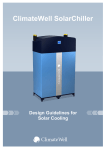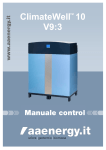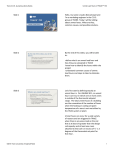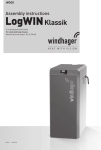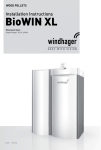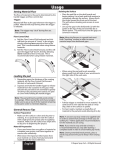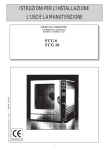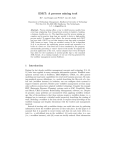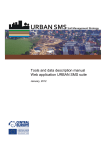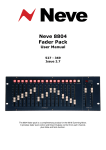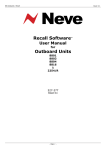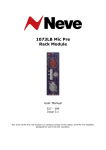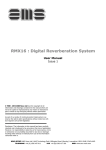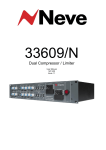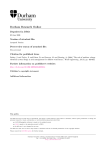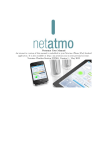Download Standard operating procedure for Biomass
Transcript
FACULTY OF COMPUTING, ENGINEERING AND SCIENCES SCHOOL OF ENGINEERING Standard operating procedure for Biomass boiler demonstration rig (F12c) Contents Scope ....................................................................................................................................................... 1 Apparatus ................................................................................................................................................ 2 Windhager biomass boiler .................................................................................................................. 2 Fuel storage......................................................................................................................................... 2 ClimateWell absorption unit ............................................................................................................... 2 Buffer storage ..................................................................................................................................... 3 Pumps and fan settings ....................................................................................................................... 3 Gate valves, air bleeds, filling loops and expansion vessels ............................................................... 3 Flow meters and thermocouples ........................................................................................................ 3 Operating procedures ............................................................................................................................. 4 Start-up procedure of the boiler (after prolonged non-use) .............................................................. 4 Shut-down for cleaning/maintenance/inspection .............................................................................. 4 Normal operating conditions (temperature or timer controlled) ...................................................... 5 Heating circuits (F12 and F12c) ........................................................................................................... 5 Absorption unit ................................................................................................................................... 5 Data acquisition ...................................................................................................................................... 6 Fuel level ............................................................................................................................................. 6 Boiler ................................................................................................................................................... 6 ClimateWell unit ................................................................................................................................. 6 Temperature and flows....................................................................................................................... 6 Maintenance ........................................................................................................................................... 7 Responsibilities ....................................................................................................................................... 8 Health & Safety (Risk Assessment) ......................................................................................................... 9 Other ..................................................................................................................................................... 10 Scope This document is aimed at relevant personnel operating the biomass boiler demonstration unit as part of the ARBOR project. It will give an overview of the different apparatus installed, operating procedures of various key moments of the unit, maintenance as well as Health & Safety guidelines. For any additional information please refer to the user manuals (located in the folder next to the boiler in F12c and/or the ARBOR personnel listed at the end of this document). Any warning sign and yellow lines should be respected at all times. Any unauthorised person should stay outside the exclusion zone at all times. This is indicated by a black and yellow striped tape on the floor. Do not touch any surfaces, pipework and parts of the chimney! Annexe 1 – Fuel price review Annexe 2 – Boiler efficiency overview (outstanding) Annexe 3 – Risk Assessments 1|Page Apparatus Windhager biomass boiler The Windhager biomass boiler (Figure 1) operates on biomass pellets (virgin wood) and has a rated output of 45kW. The unit is selfcontrolling and a daily inspection for faults/issues (indicated by the unit) or upon visual inspection are sufficient. The unit should be kept closed at all times during normal operating hours. There is no need to change any of the parameters of the unit. Fuel storage The fuel silo (black tank) can store approximately 3.5 tons of pellets. The silo can be filled by a sliding trap in the lid of the tank. Please Figure 1 - Windhager boiler consider the separate risk assessment for filling the hopper (2-3 times per heating season). Fuel levels of the storage should be checked on a weekly basis and (if required) an order should be placed (cf. Maintenance). The fuel silo is equipped with a vacuum pump filling unit that provides the boiler with pellets. Various suction probes are mounted at the bottom of the tank as shown on Figure 2. This is set to 6 hour intervals where the unit will check pellet usage over the last 6 hours and make an educated guess whether to top up the boiler or not. Because of the noise generated by this operation there is a function that allows this to be set at certain times, in our case it has been scheduled to happen at night. Figure 2 - Suction probes ClimateWell absorption unit The ClimateWell (Figure 3) unit generates between 7kW and 10kW of cooling that will be dissipated by an air blown cooler. Additionally it will generate 20-30 kW of heat (up to 40°C) also dissipated by an air blown cooler. It will draw 1520 kW of heat from the buffer storage tank. The unit is selfregulating. According to its internal temperatures it will open and close valves automatically. Bypass valves should allow a continuous flow of the various circuits for real-time temperature monitoring by the system. Figure 3 - ClimateWell 2|Page Buffer storage The buffer tank stores 825 litres of water. The heating circuits will be directly fed by this buffer tank and the ClimateWell unit will draw its heat through a flat plate heat exchanger. The buffer tank is well insulated and the thermal loss is 3.5 kWh / 24hrs (tested and verified). Pumps and fan settings There is no need to regulate any of the pump settings. All pumps are activated according to the operating conditions of the boiler and/or absorption unit. All loops are equipped with bypass valves and some of the pumps are self-adjusting to keep a constant pressure in the loop. The fan(s) can be set to either continuous mode or temperature controlled mode where the set temperature can be changed according to the desired load on the absorption unit (heat sink and refrigeration cycle). Gate valves, air bleeds, filling loops and expansion vessels There is no need to adjust any of the gate valves in the system (except during maintenance). All air bleeds are fully automatic and any air pockets in the system should automatically rise to the highest point and be automatically vented. The filling loops (located by the expansion vessels) should be checked before each heating season or prolonged non-use of the respective circuit and topped up if necessary (min. 1bar). The expansion vessels should be part of the yearly maintenance by approved service personnel. Flow meters and thermocouples The flow meters can all be read directly from their respective screens. The flow meters installed on the heat sink and refrigeration loop can display the water temperature and provide a pulsed output to be read by a computer. 3|Page Operating procedures Start-up procedure of the boiler (after prolonged non-use) - Check fuel level in silo (Be aware of the potential for a build-up of Carbon Monoxide within the silo). - Check water pressures are all above 1 bar (top up if necessary at the two filling stations located by the two expansion vessels - Figure 4). - Check for loose wires or open pipework. - Turn boiler on via control panel. - Turn absorption unit on via the wall plug as well as the pumps on the system and power supply of the flow meters. - Monitor all processes as the boiler and Figure 4 - Expansion vessel absorption unit sensors should indicate any potential problems. - Keep an eye on the pumps and check for any water leaks once the pumps start running. - Once the boiler is in ‘modulating mode’ the room should be getting warm. Shut-down for cleaning/maintenance/inspection - - - The boiler will indicate cleaning (every 1200 hrs of operating) / maintenance periods. Follow the on-screen instructions to ‘power-down’ the boiler (in case of prolonged intervention turn the absorption system off as well). When indicated on the monitor, open both boiler cover doors at the front (check for temperatures and use gloves). Open all the 3 side panels on the right (Figure 6) and Figure 5 - Dome shape air intake use a vacuum cleaner (potentially hot ash). - Use brush to sweep all visible surfaces (start at the top) and pay attention to the two temperature probes protruding from the ceiling (remove all residues). - In the combustor remove all visible ash deposits and remove the dome shaped steel part in the bottom of the combustor (Figure 5). - Use the plastic tube (on cleaning rack) and insert into the now visible hole. Attach the hoover. Careful handling is required as this is the lighting part of the boiler. Replace the dome when finished. - Clean the bottom bit of the boiler and check for any clinker in the screws. - Close the ash ports on the ash bin by pulling the handle. Figure 6 - Boiler interior 4|Page - Roll out the bin and empty in flame resistant container (Make sure to weigh the ash) Replace ash bin (make sure to lock all seals and open ash ports) and close all openings. If any of the seals are not properly closed, the boiler will not fire up (negative pressure required). Carry out any additional maintenance or servicing if required. Confirm all interventions are finished on the monitor and follow on-screen instructions (boiler will check for any open doors/vents before lighting). Chimney sweeping should be carried out by an approved person on a yearly basis. N.B. Maintenance of the absorption system does not require the boiler to be turned off Normal operating conditions (temperature or timer controlled) - No intervention is required during the normal operating condition of the boiler. The boiler can be set either to room temperature or timer control. Heating circuits (F12 and F12c) - The desired room temperature for F12 and F12c can be controlled via the respective temperature controls as any other conventional household boiler (for ease of use). Care is to be given not to overheat the rooms and the temperature should be adjusted according to occupancy levels of the room. Absorption unit - The absorption unit can be set to heating or cooling. The fans can be set to run continuous or be temperature controlled. (This will use the inlet temperatures to the respective heat exchangers and can result in the fans operating independently of each other). 5|Page Data acquisition Fuel level The fuel level needs to be monitored on a regular basis. At the back of this folder (annexe 1) there is a table to record the fuel input into the silo. The electronic version of the file allows for estimating the remainder of the fuel based on the pellets consumption and on boiler operating time. Boiler Fuel usage, temperatures and operating hours can be displayed by the boiler mounted mini-displaydisplay. This data is necessary for the excel logging of the boiler overview and fuel storage level. A paper version of this can be found in the annexe 2 of this document. ClimateWell unit The ClimateWell unit can indicate its current charge status via the display on the unit. Additionally all temperatures and energy levels can be read by a computer connected via an RS232 cable. Check the ClimateWell user manual for additional information. Temperature and flows The flows are measured with digital flow meters and can indicate flow rates as well as total accumulated water usage. The two flow meters connected to the heat sink and the cooling circuit are both able to indicate the flow temperature as well. 6|Page Maintenance Ash bin Combustor cleaning Heat exchanger (boiler) Visual Absorption Boiler Chimney Expansion vessel When? Upon request Upon request Automatic Weekly Issue / modification Yearly Yearly Yearly What? Follow instructions Follow instructions N/A For leaks, pressures Follow instructions Approved person Approved person Approved person Additional info User manual User manual Self-cleaning User manual N/a N/a N/a 7|Page Responsibilities Dean of Faculty of Computing, Engineering and Sciences: Professor Hastings McKenzie - Ensure that operational procedures are in place for the safe use of the biomass boiler demonstration rig, including preparation of risk assessments for the facility Project manager / Faculty Health & Safety advisor / Technical skills specialist Dr Sacha Oberweis Barry Cornes Audra Jones Graham Preece - Ensure that suitable and sufficient risk assessments are in place, along with any necessary instructions resulting from the finds of the risk assessment Ensure that safety instructions and operational procedures are complied with for all visitors Ensure contractors understand and comply with this operating procedure Ensure the safe operation / maintenance and inspection is carried out as indicated above 8|Page Health & Safety (Risk Assessment) There are three separate risk assessments for the boiler system (annexe 3). - Standard operating conditions Fuel loading Cleaning and maintenance 9|Page Other Version draft Date Author 29/05/2013 S Oberweis Change n/a 10 | P a g e Fuel price review ARBOR project INTERREG IVB Date From Distance Qty [miles] CO2 del. Qp [kg] CO2 prod. Cost [kWh] [kg] [kg] [£] [p/kWh] 24/05/2013 Renuvo 59 1000 4800 -1.9 -10.0 £ - £ - 29/05/2013 Agripellets 59 80 384 -0.2 -0.8 £ - £ - 6 2000 9600 -0.4 -20.0 £ Billington 535.00 £ 0.06 Risk Assessment Form Faculty of Computing, Engineering & Technology To be completed by Risk Assessor: Location of activity F12c Member of staff responsible for activity ARBOR team member Activity being assessed Biomass boiler demonstration rig Other contributors to assessment Barry Cornes Assessors name Dr Sacha Oberweis Assessor contact tel 3565 Date of Assessment 28-May-13 Assessors signature Review required No Review Date Due All completed risk assessments MUST be available to persons undertaking the activity. A copy should also be filed with Claire Booth (Faculty H&S Administrator) if appropriate. No Risk Area Hazard/Process Object or material at high temperature - When apparatus is in use 1 F12c 2 F12c Electrocution 3 F12c Fire - Biomass storage 4 F12c Trip - Trailing pipe work & cables 5 F12c Fumes - when in operation 6 F12c Manual handling - when loading the fuel hopper Persons at Risk Control Measures Staff, Students, 1. Warning notices highlighting potential thermal Visitors & hazard from boiler. Trespassers 2. Restricted access to the unit (yellow zones). 1. All wiring integrated into building infrastructure (no Staff, Students, plugs) Visitors & 2. Warning labels displayed showing location of Trespassers emergency isolation panic buttons. 1. All fuels to be properly stored away from sources of fire. Staff, Students, 2. Ensure fire extinguisher is readily available. Visitors & 3. Carbon monoxide detectors in operation to monitor Trespassers CO generation in storage. 4. Open venting system to prevent explosion from dust generation during filling operation 1. Trailing parts/leads to be kept to minimum at all times. Staff, Students, 2. Area to be maintained in a clean and tidy state at all Visitors & times. 3. All Trespassers cabling and pipework attached to walls out of reach. Severity (1-10) Likelihood (1-10) Risk Rating (S x L) Level of Risk Result (T,A,N,U) 2 4 8 Very Low A 8 4 32 Medium A 8 4 32 Medium A 4 6 24 Low A 6 3 18 Low A 6 4 24 Low A 1. Flue system to be used to direct fumes to the outside atmosphere (regular inspection). 2. Doors to other areas of the laboratory are to be Staff, Students, closed to prevent fumes entering back in to the Visitors & building. Trespassers 3. Constant monitoring of CO alarm. 4. Automatic shut-off system in case of build-up pressure in flue. Staff, Students, 1. Use appropriate manual handling procedures. Visitors & 2. Use appropriate PPE (dust mask) during loading Trespassers procedure. Control measures highlighted in bold indicate recommended improvements needed to reduce the level of risk associated with the hazard The resultant risk level is graded as follows: T (trivial risk), A (adequately controlled), N (not adequately controlled), U (unable to decide and further information required) Summary of any key comments to note (general recommendations for improvements, areas of concern, items for review or further action etc) FCET H&S/3-01a Document Rev. Date: 15th October 2010 Risk Assessment Form Faculty of Computing, Engineering & Technology To be completed by Risk Assessor: Location of activity F12c Member of staff responsible for activity ARBOR team member Activity being assessed Biomass boiler demonstration rig (maintenance) Other contributors to assessment Barry Cornes Assessors name Dr Sacha Oberweis Assessor contact tel 3565 Date of Assessment 05-Jun-13 Assessors signature Review required Yes (after first maintenance) Review Date Due All completed risk assessments MUST be available to persons undertaking the activity. A copy should also be filed with Claire Booth (Faculty H&S Administrator) if appropriate. No Risk Area 1 F12c 2 F12c 3 F12c Hazard/Process Object or material at high temperature - When apparatus is in use Persons at Risk Electrocution Staff Fire - Biomass storage 4 F12c Trip - Trailing pipe work & cables 5 F12c Fumes - when in operation Staff Staff Control Measures 1. Follow on screen instructions (cool-off period) 2. Use high temperature gloves 3. Dispose of potential hot ash in metal bin provided 1. Boiler turns itself down (check for loose wiring) 2. Warning labels displayed showing location of emergency isolation panic buttons. 3. No loose cables from vaccuum cleaner Severity (1-10) Likelihood (1-10) Risk Rating (S x L) Level of Risk Result (T,A,N,U) 7 2 14 Low A 8 4 32 Medium A 8 4 32 Medium A 4 6 24 Low A 6 3 18 Low A 1. All fuels to be properly stored away from sources of fire. 2. Ensure fire extinguisher is readily available. 3. Carbon monoxide detectors in operation to monitor CO generation in storage. 4. Open venting system to prevent explosion from dust generation during filling operation 5. Boiler will automatically lock down fuel supply inlet 1. Trailing parts/leads to be kept to minimum at all times. 2. Area to be maintained in a clean and tidy state at all Staff times. 3. All cabling and pipework attached to walls out of reach. 1. Flue system to be used to direct fumes to the outside atmosphere (regular inspection). 2. Doors to other areas of the laboratory are to be Staff, Students, closed to prevent fumes entering back in to the Visitors & building. Trespassers 3. Constant monitoring of CO alarm. 4. Automatic shut-off system in case of build-up pressure in flue. Control measures highlighted in bold indicate recommended improvements needed to reduce the level of risk associated with the hazard The resultant risk level is graded as follows: T (trivial risk), A (adequately controlled), N (not adequately controlled), U (unable to decide and further information required) Summary of any key comments to note (general recommendations for improvements, areas of concern, items for review or further action etc) FCET H&S/3-01a Document Rev. Date: 15th October 2010 Risk Assessment Form Faculty of Computing, Engineering & Technology To be completed by Risk Assessor: Location of activity F12c Member of staff responsible for activity ARBOR team member Activity being assessed Biomass boiler demonstration rig (fuel loading) Other contributors to assessment Barry Cornes Assessors name Dr Sacha Oberweis Assessor contact tel 3565 Date of Assessment 05-Jun-13 Assessors signature Review required Yes (after first loading) Review Date Due All completed risk assessments MUST be available to persons undertaking the activity. A copy should also be filed with Claire Booth (Faculty H&S Administrator) if appropriate. No Risk Area Hazard/Process Persons at Risk 1 F12c Electrocution Staff 2 F12c Fire - Biomass storage Staff 3 F12c Trip - Trailing pipe work & cables Staff 4 F12c Fumes - when in operation Staff 5 F12c Manual handling Staff Control Measures 1. Warning labels displayed showing location of emergency isolation panic buttons. 2. Check for loose wires and cables 1. All fuels to be properly stored away from sources of fire. 2. Ensure fire extinguisher is readily available. 3. Carbon monoxide detectors in operation to monitor CO generation in storage. 4. Open venting system to prevent explosion from dust generation during filling operation 1. Trailing parts/leads to be kept to minimum at all times. 2. Area to be maintained in a clean and tidy state at all times. 3. All cabling and pipework attached to walls out of reach. 1. Flue system to be used to direct fumes to the outside atmosphere (regular inspection). 2. Doors to other areas of the laboratory are to be closed to prevent fumes entering back in to the building. 3. Constant monitoring of CO alarm. 4. Automatic shut-off system in case of build-up pressure in flue. 1. Always apply safe manual handling procedures 2. Always apply safe working at height procedures Severity (1-10) Likelihood (1-10) Risk Rating (S x L) Level of Risk Result (T,A,N,U) 8 4 32 Medium A 8 4 32 Medium A 4 6 24 Low A 6 3 18 Low A 6 3 18 Low A Control measures highlighted in bold indicate recommended improvements needed to reduce the level of risk associated with the hazard The resultant risk level is graded as follows: T (trivial risk), A (adequately controlled), N (not adequately controlled), U (unable to decide and further information required) Summary of any key comments to note (general recommendations for improvements, areas of concern, items for review or further action etc) FCET H&S/3-01a Document Rev. Date: 15th October 2010
















